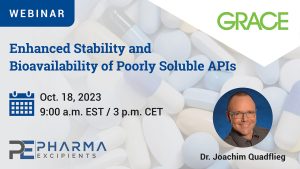The role of Eudragit® as a component of hydrogel formulations for medical devices

Over the last decade, significant progress has been made in developing hydrogels as medical devices. By physically cross-linking pharmaceutically approved polymers into three-dimensional matrices, we can ensure their biocompatibility and facilitate their seamless transition from the laboratory to clinical applications. Moreover, the reversible nature of their physical cross-links allows hydrogels to dissolve in the presence of external stimuli. Particularly, their high degree of hydration, high molecular weight, and superior flexibility of the polymer chains facilitate their interaction with complex biological barriers (e.g., mucus layer), making them ideal candidates for mucosal drug delivery. However, fine-tuning the composition of the hydrogel formulations is of great importance to optimize the performance of the medical device and its therapeutic cargo.
Herein, we investigated the influence of different Eudragits® on the properties of hydrogels based on polyvinylpyrrolidone (PVP), polyvinyl alcohol (PVA), and polyethylene glycol (PEG), which were originally proposed as ocular inserts in previous reports. Our research aims to determine the effects that including different Eudragits® have on the structure and protein ocular delivery ability of various hydrogel formulations. Properties such as matrix stability, protein encapsulation, release kinetics, mucoadhesion, and biocompatibility have been analyzed in detail.
Our study represents a guideline of the features that Eudragits® have to exhibit to endow hydrogels with good adhesion to the eye’s conjunctiva, biocompatibility, and structural strength to cope with the ocular biointerface and allow sustained protein release. This work has important implications for the design of new hydrogel materials containing Eudragits® in their composition, particularly in mucosal drug delivery.
Download the full article as PDF here The role of Eudragit® as a component of hydrogel formulations for medical devices
or read it here
Materials
The starting materials were purchased from various suppliers: Merck® (Spain) provided PEG 2 kDa, bovine serum albumin–fluorescein isothiocyanate conjugate (BSA-FITC), and phosphate buffer saline pH = 7.4. PVA 100 kDa and PVP 50 kDa were acquired from Fisher Scientific® (Spain). Evonik® (Germany) generously provided free of charge Eudragit® RSPO, RL100, S100, L100, and L100-55. 99.8% D2O NMR solvent, 99.5% glycerol, and ACS grade potassium sulphate (K2SO4) were obtained from Scharlab® (Spain). AJL Ophthalmic® (Spain) provided Balanced Salt Solution (BSS) for irrigating the tissues of the eyes. All the reagents were used as received without any further purification. Type I quality water was used for the experiments and was obtained from a purification system (18.2 MΩ cm). Thermo Fisher Scientific® (Spain) provided Dulbecco’s modified Eagle’s medium (DMEM), fetal bovine serum (FBS), penicillin–streptomycin solution (P/S) and AlamarBlue® cell viability reagent.
Journal of Materials Chemistry B, 579c, David Esporrin-Ubieto, Ana Sofia Sonzogni, Mercedes Fernandez, Arantxa Acera, Eider Matxinandiarena, Juan F. Cadavid-Vargas, Itxaso Calafel, Ruth N. Schmarsow, Alejandro J. Muller, Aitor Larranaga,Marcelo Calderon, Received 13th July 2023, Accepted 11th September 2023, DOI: 10.1039/d3tb01
See the webinar:
“Enhanced Stability and Bioavailability of Poorly Soluble APIs“,
18 October 2023:
Get more information & register here for free:


